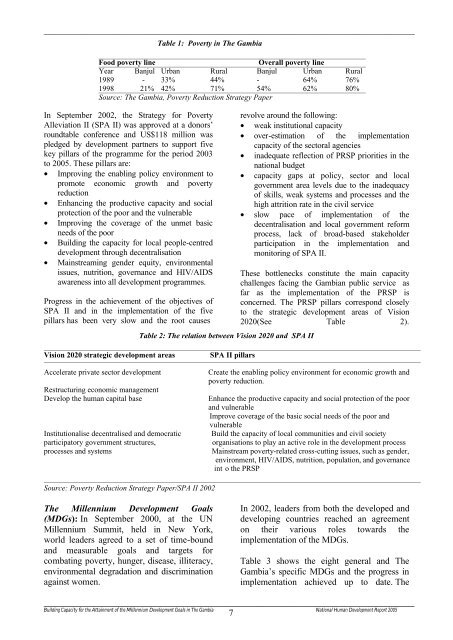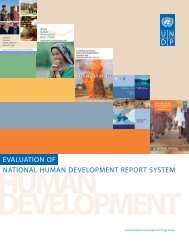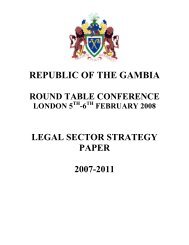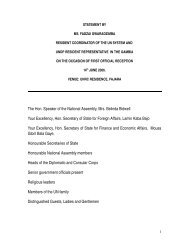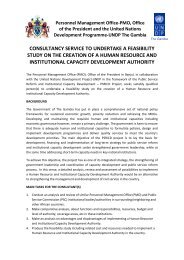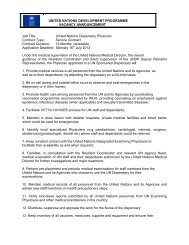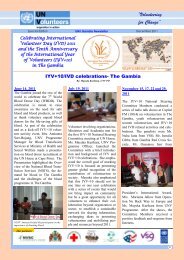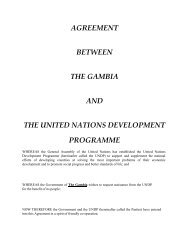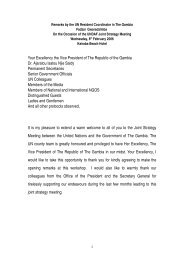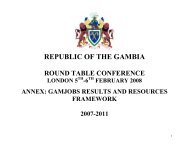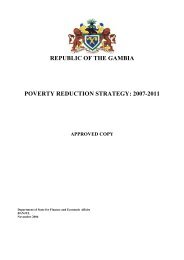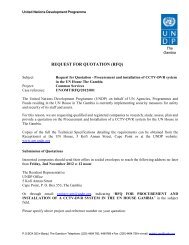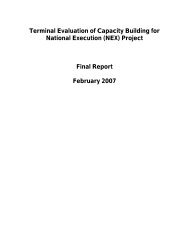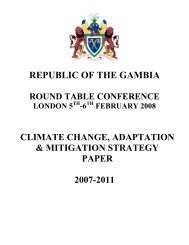Introduction - UNDP The Gambia
Introduction - UNDP The Gambia
Introduction - UNDP The Gambia
You also want an ePaper? Increase the reach of your titles
YUMPU automatically turns print PDFs into web optimized ePapers that Google loves.
________________________________________________________________________________________________________________________<br />
Table 1: Poverty in <strong>The</strong> <strong>Gambia</strong><br />
Food poverty line<br />
Overall poverty line<br />
Year Banjul Urban Rural Banjul Urban Rural<br />
1989 - 33% 44% - 64% 76%<br />
1998 21% 42% 71% 54% 62% 80%<br />
Source: <strong>The</strong> <strong>Gambia</strong>, Poverty Reduction Strategy Paper<br />
In September 2002, the Strategy for Poverty<br />
Alleviation II (SPA II) was approved at a donors’<br />
roundtable conference and US$118 million was<br />
pledged by development partners to support five<br />
key pillars of the programme for the period 2003<br />
to 2005. <strong>The</strong>se pillars are:<br />
• Improving the enabling policy environment to<br />
promote economic growth and poverty<br />
reduction<br />
• Enhancing the productive capacity and social<br />
protection of the poor and the vulnerable<br />
• Improving the coverage of the unmet basic<br />
needs of the poor<br />
• Building the capacity for local people-centred<br />
development through decentralisation<br />
• Mainstreaming gender equity, environmental<br />
issues, nutrition, governance and HIV/AIDS<br />
awareness into all development programmes.<br />
Progress in the achievement of the objectives of<br />
SPA II and in the implementation of the five<br />
pillars has been very slow and the root causes<br />
Table 2: <strong>The</strong> relation between Vision 2020 and SPA II<br />
revolve around the following:<br />
• weak institutional capacity<br />
• over-estimation of the implementation<br />
capacity of the sectoral agencies<br />
• inadequate reflection of PRSP priorities in the<br />
national budget<br />
• capacity gaps at policy, sector and local<br />
government area levels due to the inadequacy<br />
of skills, weak systems and processes and the<br />
high attrition rate in the civil service<br />
• slow pace of implementation of the<br />
decentralisation and local government reform<br />
process, lack of broad-based stakeholder<br />
participation in the implementation and<br />
monitoring of SPA II.<br />
<strong>The</strong>se bottlenecks constitute the main capacity<br />
challenges facing the <strong>Gambia</strong>n public service as<br />
far as the implementation of the PRSP is<br />
concerned. <strong>The</strong> PRSP pillars correspond closely<br />
to the strategic development areas of Vision<br />
2020(See Table 2).<br />
Vision 2020 strategic development areas<br />
Accelerate private sector development<br />
Restructuring economic management<br />
Develop the human capital base<br />
Institutionalise decentralised and democratic<br />
participatory government structures,<br />
processes and systems<br />
SPA II pillars<br />
Create the enabling policy environment for economic growth and<br />
poverty reduction.<br />
Enhance the productive capacity and social protection of the poor<br />
and vulnerable<br />
Improve coverage of the basic social needs of the poor and<br />
vulnerable<br />
Build the capacity of local communities and civil society<br />
organisations to play an active role in the development process<br />
Mainstream poverty-related cross-cutting issues, such as gender,<br />
environment, HIV/AIDS, nutrition, population, and governance<br />
int o the PRSP<br />
Source: Poverty Reduction Strategy Paper/SPA II 2002<br />
<strong>The</strong> Millennium Development Goals<br />
(MDGs): In September 2000, at the UN<br />
Millennium Summit, held in New York,<br />
world leaders agreed to a set of time-bound<br />
and measurable goals and targets for<br />
combating poverty, hunger, disease, illiteracy,<br />
environmental degradation and discrimination<br />
against women.<br />
In 2002, leaders from both the developed and<br />
developing countries reached an agreement<br />
on their various roles towards the<br />
implementation of the MDGs.<br />
Table 3 shows the eight general and <strong>The</strong><br />
<strong>Gambia</strong>’s specific MDGs and the progress in<br />
implementation achieved up to date. <strong>The</strong><br />
________________________________________________________________________________________________<br />
Building Capacity for the Attainment of the Millennium Development Goals in <strong>The</strong> <strong>Gambia</strong> National Human Development Report 2005<br />
7


